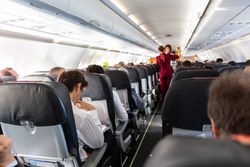
Broken bones take time to heal, and during this period, you’ll have to wear a cast to protect the affected area. Take care of yourself and avoid scenarios that can delay progress, such as air travel. Here’s more information about flying with a broken bone.
Why Might a Broken Bone Prevent Air Travel?
Your cast is designed so that it isn’t too tight, which would restrict blood flow. Adequate circulation is essential to healing because the blood supplies nutrients and oxygen, which are needed to build strong bones. Tissues can swell after the cast is fitted, constricting the area and increasing the odds of deep vein thrombosis (DVT).
 Flying elevates your risk of DVT because your movements are restricted for long periods, inhibiting circulation. For your safety, some airlines may prevent you from flying if your cast was fitted recently. If you need to fly for an emergency, like an urgent family matter, the airlines may request that the cast be split along its length for the flight. A split cast gives tissues room to expand safely; however, you’ll need to reseal it immediately upon arrival.
Flying elevates your risk of DVT because your movements are restricted for long periods, inhibiting circulation. For your safety, some airlines may prevent you from flying if your cast was fitted recently. If you need to fly for an emergency, like an urgent family matter, the airlines may request that the cast be split along its length for the flight. A split cast gives tissues room to expand safely; however, you’ll need to reseal it immediately upon arrival.
How Can You Assure Comfortable Flying?
To avoid impediments to your travel, ask your doctor to provide you with a medical letter to show the airline. It should state when you were injured and when the cast was fitted. You may have to show this document before boarding so that the crew knows your cast wasn’t fitted recently, and you’re cleared for air travel. If you have a foot or leg injury, book a seat with extra legroom for your comfort. You can also ask to board early so that other passengers don’t accidentally jostle your broken bone.
If you have more questions about flying with a broken bone, contact the office of Peter A. Matsuura, M.D., in Hilo, HI. Dr. Matsuura and his team will take the time to create a nonsurgical treatment plan that’s suited for your injury and lifestyle. View their full list of services online, or call (808) 969-3331 to schedule an appointment.
About the Business
Have a question? Ask the experts!
Send your question

